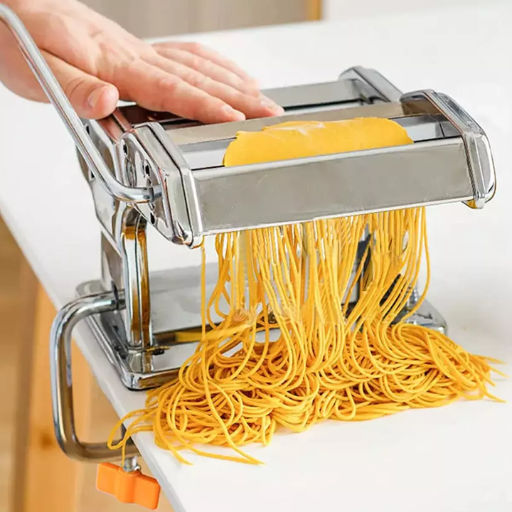Producing fresh pasta from home may completely revolutionize your cooking experience, providing flavors and textures that pre-made noodles cannot match. This is an all-inclusive study that will reveal the top-performing pasta makers in 2024, having been reviewed extensively to aid you in finding the perfect machine to make pasta for yourself. Our guide caters to different machines ranging from user-friendly devices suitable for beginners to high-end units with advanced features meant for professional chefs, thus covering a wide range of kitchen appliances and expertise levels. Let’s look at some of these brands while considering their strengths, such as functionality, durability, or any other unique qualities they may possess that will help you decide how best to enhance your pasta-making skills.
What is the Best Pasta Maker to Buy in 2024?
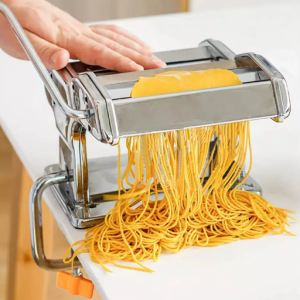
Image source: https://www.ebay.com/
When selecting the best pasta-making machine to purchase in 2024, many things need to be considered, like simplicity, longevity, adaptability, and general performance. One product that stands out is the Philips Pasta and Noodle Maker. Its easy-to-understand design makes this machine automatically mix, knead, and extrude pasta with little intervention from the user, thus making it suitable for newbies and cooking experts. Furthermore, it comes with various interchangeable discs for creating different pasta shapes, ensuring culinary innovation. Most people opt for this brand during this time because of its solid track record in dependability coupled with consistent outcomes. The Philips Pasta & Noodles Maker guarantees you perfect homemade pasta every single time throughout 2024.
Understanding Different Types of Pasta Makers
Several pasta makers have been created to cater to individual needs and tastes.
- Manual Pasta Makers:
- Description: These old-fashioned machines require the user to roll and cut dough by hand. They are loved for their authenticity and for their ability to control thickness and consistency.
- Pros: They are usually cheaper, more robust, and do not need electricity; they suit those who like things done the traditional way.
- Cons: It takes more time and effort, which may be inconvenient for busy cooks.
- Description: These appliances automate much of the pasta-making process – kneading dough, mixing all ingredients together, extruding it through dies.
- Pros: It is quick, convenient, and perfect for those who make pasta often. It is straightforward to use, hence ideal for beginners as well.
- Cons: Generally cost more than manual models; bulkier occupies more kitchen space; requires electricity supply.
- Pasta Extruders:
- Description: Attachments or separate devices that push out dough via discs, thus creating various shapes, e.g., penne rigate, rigatoni.
- Pros: Offers many types of pasta with little effort required. Attachments can also be used with stand mixers.
- Cons: They are more expensive compared directly with manual rollers since some still need manual input during preparation; standalone ones tend to be pricey, too.
Knowing these categories should help you make better choices depending on how often you cook, what forms of pasta you want to create, and your budget, among other factors.
Features to Look For in the Best Pasta Maker
To select the best pasta-making machine, think about these essential things:
- Quality of the Material and Build: Opt for a machine made from high-quality materials such as stainless steel, which is durable and easy to clean. However, plastic parts should be strong enough to withstand regular use.
- User Friendliness: Machines should be equipped with simple controls and understandable manuals, whether they are electric or manually operated. Moreover, they must have adjustable thickness settings, among other features.
- Flexibility: This factor should also be considered since it determines how many shapes or types can be made using one machine simultaneously without buying any other devices separately. Some machines come with interchangeable disks/attachments that allow different forms of pasta, such as fettuccine, spaghetti, and ravioli.
- Ease of Cleaning and Maintenance: Look for models with removable parts that can be washed individually or tossed into a dishwasher altogether.
- Protection Measures: A safe pasta maker must have non-slip bases that provide stability while being used. It should also feature guards, especially if it is manual, to keep fingers from getting hurt during operation.
- Dimensions and Storage Space Required: Consider the size of your kitchen where you plan on storing this appliance after use. If space is limited but you still want something with all the necessary functions, go for compact designs. Alternatively, get yourself a unit with additional storage compartments for accessories, hence saving more room within the house.
-
Price-Range Awareness/Warranty Terms Comparison: Finally, balance affordability vis a vis desired qualities/features, plus check if there’s any warranty covering defects, etcetera.
These features are helpful when selecting a pasta maker that meets one’s cooking requirements and style.
Top Recommendations for Pasta Makers in 2024
- Marcato Atlas 150: Marcato Atlas 150 is famous for its construction and adaptability. It’s made of long-lasting chrome-plated steel and has numerous settings for pasta thickness. Many cooking lovers prefer it because it’s easy to use and maintain. Also, this model has some additional features that help to make different pasta shapes.
- Philips Pasta and Noodle Maker: Regarding easiness, Philips Pasta and Noodle Maker couldn’t be beaten. This electric machine is fully automated and capable of mixing dough with other ingredients and kneading them before extruding out-shaped pasta within minutes. Its controls are easily operated even by a beginner; those parts can also be washed using a dishwashing machine, whereas more than one variety may be created simultaneously, thus making the whole process much less time-consuming when compared against manual methods.
-
Imperia Pasta Maker Deluxe Set: Classic design meets durability—The Imperia Pasta Maker Deluxe Set has always been appreciated for its sturdy construction and various attachments, such as a spaghetti cutter or fettuccine cutter. The traditional crank operation gives users a hands-on experience while ensuring convenience during usage and maintenance.
How to Use a Pasta Maker: A Step-by-Step Guide

- Create the Dough: Begin with preparing the pasta dough. Combine flour, eggs, and a suggestion of salt in a bowl until it forms an elastic dough that is smooth to the touch. Allow it to rest for around half an hour to relax gluten.
- Set Up Pasta Maker: Attach the pasta maker to your countertop or secure it according to the instructions provided by its manufacturer; ensure stability before starting anything.
- Roll Out The Dough: Divide the rested dough into smaller parts. Flatten one part using your hands, then set the pasta maker at its widest setting. Pass through the rollers once, fold, and repeat several times, gradually reducing thickness until the desired thinness is achieved.
- Cut the Pasta: When the sheet of dough reaches the thickness you like, switch to the cutting attachment for the shape of pasta you want, e.g., spaghetti or fettuccine; feed slowly but steadily through the cutter.
-
Cook Or Dry The Pasta: At this point, cook fresh pasta immediately in boiling salted water until al dente can still hang it up somewhere dry out for later use. Following these simple steps will enable you to prepare tasty homemade pasta effortlessly.
Following these easy steps will help you create delicious homemade pasta every time.
Preparing Your Pasta Dough
Take three large eggs and two cups of all-purpose flour for the pasta dough. On a clean surface, hollow out the flour and pour in the eggs. Gradually mix with a fork or your hands, bringing in flour from all edges until you have a lumpy mixture. Knead this for about 8-10 minutes until smooth and stretchy; if it seems sticky, add some more flour, but if dry, put water in one teaspoon at once. Wrap up in clingfilm and let rest somewhere warm for under half an hour before rolling into sheets or any other shape of pasta desired.
Rolling Out the Perfect Sheets of Dough
First, dust your work surface and roll the pin with flour so that the dough does not stick. The rested dough is divided into smaller pieces, which are then covered except for one to prevent them from drying out while you work on them. Slightly flatten the piece of dough using your hands.
When you use the rolling pin, roll it outwards from the center, rotating severally so that its thickness may remain even between 1-2 mm. If a pasta maker was used, fold and turn the rollers after each pass since they should be set at their broadest point for this machine. Slowly reduce these measurements until you realize the desirable thinness by passing through continuously. In case transparency is observed upon being spread, know that there is smoothness in doing so.
Cutting and Shaping Your Pasta
Once your pasta dough is ready, the next step is to cut and shape it into the desired pasta form. If making tagliatelle or fettuccine, sprinkle a little flour on top of the sheets of dough, then fold them loosely before cutting them into strips using a sharp knife – the width should be as per your preference. For filled pasta such as ravioli, square off pieces from rolled-out dough with either a ravioli cutter or regular knife, place small portions of filling at the center part, and fold over before sealing edges together firmly. Farfalle can be made by cutting small rectangles out of flat pieces; pinching each one at its middle point thus creating that characteristic bow-tie shape. Pasta machines usually come with attachments for different cuts hence making work more manageable when using them too. If possible, however, let dry slightly after cutting to avoid sticking while cooking.
What are the Pros and Cons of Manual vs. Electric Pasta Makers?
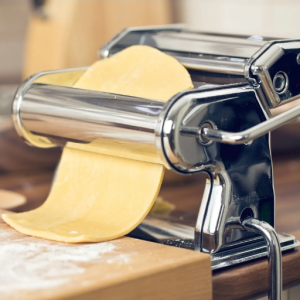
Manual Pasta Makers
Pros:
- Control: Better control over rolling and cutting, more hands-on.
- Cost: Usually cheaper in terms of price than electric models.
- Durability: Often made with fewer parts that can break down and thus last longer.
- Authenticity: Provides the traditional experience of making pasta, which pleases many people.
Cons:
- Effort: More physical work and time are needed to roll out and cut the pasta.
- Skill Requirement: Beginners may find it harder to learn how to use them at first because they have a higher learning curve than other types of machines, like this one, which does not require much skill or effort from the user.
Electric Pasta Makers
Pros:
- Convenience: It takes significantly less time and energy to make pasta when you use an electric machine instead of doing everything manually; this is especially true if someone is busy or tired after work. Then, they can just put ingredients into an automatic cooker, set the timer on it, go take a shower, come back home, and a ready meal is cooked. What could be easier?
- Consistency: There will be no variation among thicknesses since these appliances produce uniform shapes through their cylinders and hardly need any operator intervention.
- Speed: They make faster batches suitable for large gatherings or meal preparation at once.
Cons:
- Cost: Generally costlier compared to manual counterparts.
- Maintenance: Electric versions often break down more frequently due to their complexity, leading to higher chances of breakdowns necessitating frequent repairs. The user must maintain them regularly; otherwise, they may stop functioning altogether, which means buying another one sooner rather than later. However, they can serve quite long without issues with proper care, so always keep them clean, dry, and well-lubricated.
- Less Authentic: They lack the touch feeling associated with hands making dough into various forms, such as ravioli, tortellini, lasagna, etc., thereby robbing some people of their fun moments while cooking together as family, friends, and neighbors.
Comparing Ease of Use and Cleanup
When you compare manual and electric pasta machines, the two most important things to consider are how easy they are to use and clean.
Although they give you greater control over the process and allow for a more traditional experience, manual pasta machines generally call for more physical exertion and skill. Rolling and cutting noodles can be challenging – especially if you’re making them in large quantities. Because fewer parts are involved in their construction, cleaning up after using one is usually straightforward; however, getting all those bits of dough out from between its crevices might take some time.
Electric pasta makers are all about convenience and speed; these machines do everything fast with just a few simple steps that require little effort. They mix, knead, and extrude automatically so that users need only intervene manually, rarely, if ever, so that each noodle turns out uniform every single time. On the other hand, because there’s more stuff going inside an electric pasta maker than inside its non-electric counterpart, this means taking apart many different pieces, which must be cleaned separately – potentially eating up quite a bit of your day. Some models even have components that can be safely washed in a dishwasher, thereby further simplifying matters when it comes down to tidying everything away again afterward.
In short, this means that while manual versions may involve comparatively few stages during setup or, indeed, disassembly later on when compared to their electrical cousins, they do require much steadier hands than those necessary for working with anything automatic, like my favorite kitchen gadget ever invented by man: the electric pasta maker.
Are There Specialized Pasta Attachments for KitchenAid Mixers?
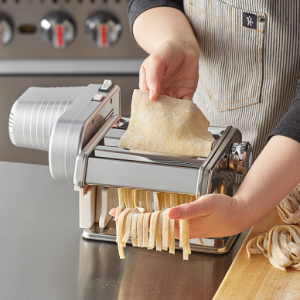
Yes, specialized pasta attachments are available for KitchenAid Mixers. You can find a range of these accessories made by Kitchenaid that can turn your mixer into an all-in-one pasta maker. Some of the attachments included in this product are the roller, which rolls out sheets of dough to any thickness you want, and cutters that make spaghetti or fettuccine, among others. Moreover, there is also an extruder attachment, which creates different shapes like rigatoni or fusilli, etcetera. These tools were designed with convenience and simplicity, so they should be easy for anyone who wants them.
Overview of the KitchenAid Pasta Maker Attachment
The KitchenAid Pasta Maker Attachment is a flexible accessory meant to extend the cooking abilities of your KitchenAid stand mixer. This set usually includes a pasta roller and several cutters, allowing you to make spaghetti, fettuccine, and lasagna sheets, among other types of pasta. The pasta roller presses dough into flat, even pieces that can be made thick or thin according to preference through its settings. These sheets are then turned into uniform pasta strands using included cutters.
Extra attachment set models may also come with a pasta extruder that helps create more elaborate shapes, such as rigatoni or fusilli. Attachments like these are created using high-quality materials that ensure their durability while also being dishwasher-friendly for easier cleaning up after use. The simplicity in design and convenience brought about by these attachments make them an invaluable addition to any kitchen since they enable even amateur cooks to achieve professional-quality pasta without much effort.
Using the 3-piece Pasta Roller and Cutter Set
To use the 3-piece Pasta Roller and Cutter Set, attach the pasta roller to your KitchenAid stand mixer’s power hub. Select the lowest speed setting on your stand mixer and feed a small portion of dough into the roller; then, increase the thickness gradually by passing it through several times at each setting. Once you have a dough sheet, switch to the desired cutter attachment — such as spaghetti or fettuccine. At a low speed, feed flattened dough through a cutter for even strands of pasta. To avoid sticking, dust with flour generously, and follow these rolling and cutting tips as the manufacturer directs.
When everything is cooked, take apart the attachments used in making this dish before cleaning them according to the care instructions given with every purchase so that they last longer. Most are not dishwasher safe but need only be wiped down using a damp cloth or brush manually, which will keep the attachments looking good over time. With these few steps, anyone can easily prepare different types of fresh homemade pasta.
The versatility of the Pasta Attachment for KitchenAid
The stand mixer’s versatility can be significantly improved by the KitchenAid Pasta Attachment, which enables users to make different kinds of pasta accurately and efficiently. Some rollers and cutters can be used at home to prepare classic spaghetti, fettuccine, and more specific types like linguine or lasagna sheets. Moreover, pasta and other culinary delights such as dumplings, wontons, or flatbreads can be made using these rollers to flatten dough. This flexibility saves space on countertops because it replaces many kitchen appliances with one; additionally, it provides satisfaction from cooking meals from scratch at home. Amateur and professional chefs find this tool irreplaceable due to its ease of use and reliable performance over time.
How to Make Gourmet Pasta at Home
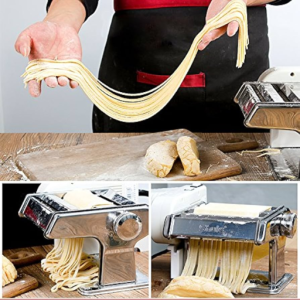
Making craft pasta at home is tricky, starting with choosing high-quality ingredients. Begin by preparing dough using flour, eggs, and salt. Work the dough until it becomes smooth and elastic, then set aside for about 30 minutes to rest. When ready, you can use the KitchenAid Pasta Attachment, which helps roll out or cut into any desired shape. For perfect firmness, cook pasta in plenty of salted boiling water until the dente stage. Complement freshly cooked noodles with gourmet sauces made from scratch using fresh top-notch produce to heighten its luxury status. If you keep doing this while being keen on details, eventually, you will be able to prepare restaurant-quality pasta dishes right from your kitchen.
Choosing the Right Flour for Pasta Dough
When making pasta dough, you must know what flour to use. Here are three flours that are usually suggested:
- Tipo 00 Flour: This Italian flour is appreciated for its softness and high protein content, which gives smoothness mixed with strength, resulting in delicate, wavy pasta.
- Semolina Flour: Semolina has higher gluten levels because it is ground from durum wheat, making its texture gritty or coarser than other flours used for pasta. This type of dough is tougher and more elastic, so shapes like penne rigate or macaroni can be produced easily.
- All-Purpose Flour: All-purpose flour offers versatility when one doesn’t want any specific kind; although not as refined as tipo 00 nor firm as semolina, good-quality pasta can still be achieved using it, considering that almost all homes have this ingredient readily available.
Different types of flour will impart different characteristics to your dough, so choose wisely based on the recipe and type of pasta desired.
Techniques for Making Fresh Pasta
Creating fresh pasta is an art that requires carefulness and a little bit of experience.
- Kneading the Dough: Mix your preferred flour with eggs until you have a homogeneous mass. Knead the dough on a floured surface for at least ten minutes to develop the gluten and make it smooth and stretchy. Kneading correctly is essential if you want perfect pasta texture.
- Resting the Dough: After kneading, wrap the dough in plastic wrap and let it rest for about thirty minutes at room temperature. This resting period helps relax the gluten, which makes rolling out later easier.
- Rolling Out The Dough: Use a rolling pin or pasta machine to roll your dough into desired thickness levels. Begin with the thickest setting on the pasta machine and progressively move onto thinner settings. Sprinkle flour over the dough as necessary to prevent sticking.
- Cutting the Pasta: Once rolled out, use a sharp knife or pasta cutter to cut the dough into desired shapes. Whether fettuccine, tagliatelle, or ravioli, ensure even sizes for uniform cooking.
- Drying the Pasta: If you are not cooking noodles immediately, dry them slightly by spreading them out on a floured surface or hanging them over the pasta drying rack for around fifteen to twenty minutes to avoid sticking them together.
- Cooking Fresh Pasta: Fresh pasta cooks much faster than dried ones. Boil in salted water for 2-3 minutes until the pasta floats on top, then drain and serve right away with your favorite sauces and toppings.
With these skills under your belt, there will be no need to go out for restaurant-quality homemade deliciousness again.
Creative Pasta Shapes and Flavors
You can try different shapes and flavors to make your homemade pasta more interesting. Here are some ideas based on what is currently trending:
- Shapes: In addition to the common types like spaghetti or fettuccine, you could make orecchiette, which means ‘small ears’ in Italian, or garganelli, which are rolled tubes that can hold sauce inside them. Using a gnocchi board will give the surface grooves that help retain more sauce, thereby maximizing every mouthful.
- Flavors: Mix natural additives into your pasta dough for taste and visual appeal. Pureed spinach or kale gives it a delicious green color with subtle earthy notes. Alternatively, beetroot may be used to achieve pink/red shades, while squid ink delivers a great salty taste and intense blackness. Light infusions of herbs and spices like rosemary or saffron can create complex flavors that elevate dishes further.
- Filled Pasta: Another way to add excitement is by making stuffed pastas such as ravioli, tortellini, and agnolotti. Each bite brings forth a surprise package of deliciousness waiting inside. The fillings can be traditional or unorthodox, like roasted butternut squash with sage, goat cheese, and sun-dried tomato.
By trying out these suggestions in terms of shapes alone, you will create visually appealing meals and yummy ones, too.
What are the Best Budget Pasta Makers Available?
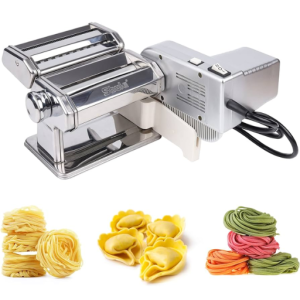
When it comes to cheap pasta machines, quite a few good options offer you plenty of bang for your buck without skimping on quality. Here are three top recommendations:
1. Marcato Atlas 150
The Marcato Atlas 150 is a highly-rated manual pasta maker known for being durable and easy to work with. Manufactured in Italy, it boasts a solid build and adjustable settings. It allows you to roll the dough out to the desired thickness and cut the pasta into various shapes, such as lasagne, fettuccine, or tagliolini. This device is perfect for anyone who wants a traditional hands-on experience making their noodles but doesn’t want to pay too much money doing so.
2. Philips Compact Pasta Maker
For those who prefer an electric model over manual labor, the Philips Compact Pasta Maker is both compact in size and user-friendly in design—this appliance will do all the hard work for you! It mixes, kneads, and extrudes dough in just 18 minutes. While it does cost slightly more than most non-electric models, its ease of use coupled with time-saving features have made this one of the best-selling kitchen gadgets among home cooks worldwide.
3. OxGord Pasta Maker Machine
The OxGord Pasta Maker Machine is another excellent choice if you’re looking for versatility at an affordable price point. With adjustable rollers and blade attachments, this machine can produce anything from spaghetti to linguine to lasagna sheets! Its sturdy construction combined with a straightforward design makes it perfect not only for beginners but also for those living on tight budgets.
These three machines strike a great balance between being inexpensive yet functional enough to provide high-quality results—which should be music to any penny-pincher’s ears who wants to get started making homemade pasta ASAP.
Features of Budget-Friendly Pasta Makers
If you want to find a pasta maker that is friendly for your budget, there are many things to consider. Here are some key features to look at so that you get the most value for money:
- Construction Material: Durable materials like stainless steel or heavy-duty plastic should be used to make quality pasta, even if they are affordable. This will help them withstand wear and tear over time.
- Adjustable Settings: Machines with adjustable thickness settings and versatile cutting options should be chosen because they allow the production of different types of pasta, such as spaghetti, fettuccine, or lasagna sheets.
- Ease of Use: The manual ones should have user-friendly crank handles, while electric models should come with stable clamps to secure the machine onto the countertop. For those that run on electricity, automated features such as dough mixing and extrusion save time and effort.
- Cleaning and Maintenance: You should choose models whose parts are easy to disassemble and clean. Some may even be dishwasher safe, whereas others might only need a quick wipe-down.
- Size and Storage: Compact machines save space and make storage easier in kitchens where there isn’t much room available; therefore, one must ensure that he/she buys an appropriate size that fits comfortably on his/her countertop and inside storage areas.
- Price and Warranty: When choosing a pasta maker within your budget range, it’s good to consider whether it comes with a warranty from its manufacturer since this gives more assurance plus adds value on top of what one has paid for already.
With these features in mind, any person mindful about their spending can still enjoy homemade pasta without compromising functionality or quality.
Finding Value without Compromising Quality
When it comes to finding a pasta-making machine that is affordable but does not compromise on quality, many websites can help. Good Housekeeping has been ranking the Philips Pasta Maker as one of their top choices because it is easy to use, fast to assemble, and offers a lot of different pasta shapes. Another reason why this product lasts so long is its heavy-duty construction materials, which make them durable. Wirecutter considers Marcato Atlas 150 Manual Pasta Maker as one if not the best manual pasta maker available in the market, saying that it has good build quality, adjustability options, and works smoothly while used. Compactibility feature and strong materials for manufacturing process are some factors taken into account by BBC Good Food which also recommended Lakeland Pasta Machine based on budget-to-functionality ratio; they also mentioned accessible cleaning properties of this device among others like storage design.. These suggestions ensure that your purchase will be strong enough to last through years’ worth of different pastas.
Frequently Asked Questions (FAQs)
Q: How do I choose the best manual pasta maker for homemade pasta?
A: When choosing the best manual pasta maker for homemade pasta, consider factors such as build quality, ease of use, and additional attachments. Highly regarded options include the Marcato Atlas 150 Pasta Machine and the OxGord Pasta Maker, which provide high durability and excellent performance.
Q: What are the benefits of using a noodle maker versus buying dried pasta?
A: Using a noodle maker to make pasta provides the advantage of fresh, flavorful noodles that can be customized to your liking. Fresh homemade pasta typically has a better texture and taste than store-bought dried pasta.
Q: Is there a significant difference between a noodle maker and a pasta maker machine?
A: While both terms are often used interchangeably, a noodle maker is specifically designed for creating noodles, whereas a pasta maker machine can make various pasta types, including noodles, spaghetti, and lasagna sheets. Some advanced machines serve both purposes efficiently.
Q: What should I look for in the best electric pasta and noodle maker?
A: The best electric pasta and noodle maker should have robust motor power, multiple settings for different pasta types, easy operation, and simple cleaning procedures. The Philips 7000 Series Pasta Maker is a top choice known for its quality and versatility.
Q: Can a pasta cutter help me make different pasta shapes?
A: Yes, a pasta cutter is an essential tool for creating various pasta shapes. Some pasta cutters come with multiple blades to produce different shapes like fettuccine, spaghetti, and ravioli, which adds diversity to your homemade pasta dishes.
Q: How do I use a pasta drying rack to improve my pasta-making process?
A: A pasta drying rack is used to hang fresh pasta to dry evenly, preventing the strands from sticking together. This step is crucial for achieving perfect texture and avoiding clumping. It is beneficial for long pasta types like spaghetti and fettuccine.
Q: Is the Marcato Atlas 150 Pasta Machine beginner-friendly?
A: Yes, the Marcato Atlas 150 Pasta Machine is beginner-friendly due to its straightforward design, durable build, and reliable performance. This machine is excellent for those new to pasta making and professionals alike.
Q: What are the advantages of a pasta maker attachment for KitchenAid mixers?
A: A pasta maker attachment for KitchenAid mixers, such as the pasta roller attachment, allows you to utilize your mixer’s motor to roll and cut pasta efficiently. It offers convenience and saves space, making it an excellent option for KitchenAid mixer owners.
Q: Can I make pasta without a pasta press?
A: You can make pasta without a pasta press by hand-rolling the dough with a rolling pin and cutting it with a knife. However, a pasta press significantly simplifies the process and ensures consistent thickness and shape of the pasta sheets.
Q: What is included in a typical pasta maker deluxe set?
A: A typical pasta maker deluxe set includes a pasta machine (manual or electric), various pasta cutter attachments, a pasta drying rack, and sometimes additional tools like a pasta roller attachment and cleaning brushes. This set provides everything you need to start making professional-grade pasta at home.












